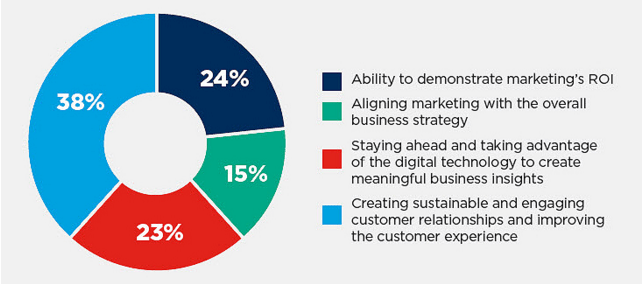As the leading marketing management consultants in APAC, it is natural that a lot of marketers and advertisers discuss the issues that keep them up at night with us, from digital integration and transformation to maximising media transparency and value to getting more effectiveness and efficiency from their ever growing roster of agencies and suppliers.
It is therefore always interesting to get an independent perspective on the industry and the challenges and issues such as this Korn Ferry Institute, Marketing Pulse Survey from December last year.
According to the report, when it comes to their primary marketing objectives, the ones keeping CMOs awake at night include:
- Creating sustainable and engaging customer relationships and improving the customer experience
- Ability to demonstrate marketing’s ROI
- Staying ahead and taking advantage of digital technology to create meaningful business insights
- Aligning marketing with the overall business strategy

Interestingly the latest Senior Marketers Monitor from the Australian Marketing Institute and Colmar Brunton highlighted that the top 5 priorities of Australian marketers were very similar:
Senior Australian Marketer Marketing priorities
- Focus on development of customer and market insights
- Focus on measures to increase sales
- Focus on maximising efficiency of marketing expenditure
- Focus on customer acquisition
- Focus on demonstrating ROI
AMI / Colman Brunton 2016 Australian Senior Marketer Monitor
But what is underpinning this common focus for Global and Local marketers? Through our work we are doing with a wide range of marketers from local to regional and global companies we have identified industry trends and observed patterns of behaviour that provide insights into these concerns and priorities.
But firstly, indulge me in changing the order of what keeps CMOs and Marketing Leaders up at night to provide some context and order to the issues identified.
1. Why digital technology keeps CMOs awake at night
Is it any wonder this made the list? The real surprise is that it is not top of their concerns considering the amount of content in the market talking about digital disruption and digital transformation.
The technology vendors are spending a fortune in creating demand for the latest technology toys to sell and the media is all too ready to write about the latest innovation as lazy journalism designed to feed the content hungry internet.
The fact is that the technology alone is no panacea to solving the issues marketers are facing. Cynically some marketers believe that these challenges have been caused by technology and blame social media and the Internet for making marketing so much more complex. But technology is an enabler it is not the solution.
As any marketer who has invested heavily in technology will tell you, in many ways the easiest part is to make the decision, the hard part is the implementation and the user training to get any value out of that technology investment. Any technology decision should be framed by the strategic requirements of the business and the brand and with a view on the return on the investment.
2. Aligning marketing with business strategy
For something so logical, it is surprising that many marketing teams find this a challenge. Often it is because marketing is positioned as a service supplier within the organisation, reduced to taking requests from the business to produce promotional materials and sales support.
Or it could be that marketing is not talking the same language as the rest of the business and discussing long-term brand value and brand health is failing to engage the management team.
Whatever the cause, it is essential for marketing to not just align to the business strategy but to contribute to the business strategy. The best and broadest definition of marketing I have heard is that “marketing is the face of the organisation to the market”.
This is where business strategy and objectives are crystallised and fulfilled through a strategy to take the business offering to market and realise the value inherent in the business. But increasingly there is also the opportunity for marketing to bring market insights back into the business and inform the business strategy. In organisations where marketing is simply a service provider, these insights are often overlooked.
3. Customer relationships and customer experience
Smart marketers have identified this trend that is moving marketing and its influence from brand through communications and advertising to brand through customer experience and relationships.
This has been enabled by technology to allow marketers to take a more holistic view of the customer and to plan and influence the customer experience across the various touch-points within the organisation.
This has been seen in the C-Suite with the rise of the Chief Customer Officer in a number of organisations including Virgin Australia and AMP.
This evolution acknowledges that brands and brand value is created not just through communications, but is more powerfully influenced through the experiences people have with the brand, either directly or indirectly.
It is this evolution that is requiring marketers to embrace collaboration as an operating principle within their organisations. Marketing is increasingly playing an influencer role to ensure the brand is reflected in the customer experience, as the customer experience is delivered by the organisation as a whole.
4. Demonstrate marketing’s return on investment (ROI)
Marketing ROI is often talked about, but since the Financial Crisis eight years ago, the imperative to demonstrate the ROI of the marketing spend has increased significantly. The CFO and the procurement team have driven the constant downward pressure on marketing costs.
But as the saying goes, you cannot cut your way to growth, the CFO is looking to their marketing counterpart to prove the return and convert the spend into an investment.
The issue for the CMO is that marketing, unlike sales, is a medium to longer-term investment, in a financial system that takes a quarterly or annual view of customer value. In discussing life-time customer value with a CFO, he jokingly said that from an accounting perspective all the company customers effectively die on the last day of the financial year only to be resurrected the next.
But the pressure is also building on marketers to provide ROI due to the increased data available through the application of technology and the ability to track and measure customer behaviour, especially on-line.
Ultimately the value of marketing is in the ability to contribute to the delivery of the business objectives, both in short-term revenue generation and in creating longer-term sustainable value.
The challenges for CMO and Marketing Leaders
The Korn Ferry Institute findings all point to what we already know. The market is changing and these changes are driven by technology and innovation. But technology alone will not provide the solution.
While the market may be more challenging and more dynamic than before, it is increasingly important for marketing to align with the business strategy to build value through the management and co-ordination of the customer experience and relationships.
Technology solutions are the enabler to achieve this, but their choice and application must be framed in their ability to deliver the return on the marketing investment.
This post first appeared on Simple.
TrinityP3’s Marketing Business Alignment service strikes at the heart of our reason for being: driving enhanced marketing performance via alignment of process and commercial purpose.
Why do you need this service? Read on to understand more





5 thoughts on “What’s keeping the Chief Marketing Officer awake at night?”
Hmmm. Having been in this game too long, the list of things that kept me, the marketer awake in 1995 were also; insights, products and experiences, ROI, and alignment with strategy. I did have an amusing conversation then with a big global agency who told me not to worry about this internet thing. But I did anyway. In 2016 the themes haven’t really changed for any marketer smart enough to know what’s good for them to worry about. Either two things are happening. 1. These are the universal pervasive concerns of good marketers. 2. Nobody can be arsed to solve the big issues so we keep worrying whilst doing nothing. I hope the former and fear the latter. The alternative is that such surveys are meaningless repeaters of obvious truisms. Which couldn’t possibly be true.
Hi Jon, I think that all this 'Internet Thing" has done is added further complexity and a pile of buzz words and TLA to a category already adept at creating them. Having just spoken for two hours on Marketing last weekend at the Sydney Business School EMBA course I think the problem is that no-one can even define marketing and its role within some organisations so no wonder marketers are concerned about relevance, ROI and alignment to strategy.
I’m bored of the ‘role of marketing’ angst. It’s either lazy thinking by marketers or people trying to justify why they do the things they want to do, instead of what they should do.
Unless I am missing something marketing’s role has always been “to affect the behaviour of the end consumer in ways that deliver against the organisations outcomes.”
Behavioural. End consumer. Outcome oriented.
They do this by pulling a combo of only three levers.
Product, mental availability, physical availability.
You need a combo of a product / service that meets a need, made mentally and physically available to those consumers. The better the product service / mental availability / physical availability the better the outcome.
Hereby I attempt to give you marketing defined. .
Technology can affect all three of those levers. Which is awesome. But as you said it also throws up a heap of things that don’t – creating fear uncertainty and doubt.
If the marketing organisation focuses on changing consumer behaviour, in a way that’s aligned to the organisations required outcomes, by making better stuff, more attractive and shoppable they’ll find they are the most useful department in the business.
When they stray from that path is when in my experience they fail. And in many ways that’s not a bad outcome for the business or our discipline.
If this notion truly is an issue we should find a way to do something about it. Any ideas?
Jon, do you think the reason that people are confused about the role of marketing is because as there has been an increase in the number of points of interaction with the consumer / customer there has been a corresponding rise in the specialists in each of these areas created the illusion that marketing is fragmented and multi-disciplined? I have personally seen marketing in organisations where is limited to comms / advertising and is largely a promotions department. In others where it is responsible for all three areas you define "Product, mental availability, physical availability". And again where the brand and business only exist online in a digital world of e-commerce and social media selling. All are called marketing.
Interesting. And may be worth a post all of its own if I can summon up the hubris required to attempt to suggest answers. I’m wary of trying to more publicly define a discipline so rife with vested interests opinions and egos. And yes I include my own.
I do think the increasing number of ways of interacting with consumers has confused some folks. And because there’s money to be made in selling new interactions it’s become a self inflating prophecy of people selling things without understanding their role, to other people who’ve lost sight of why they were doing things in the first place. So maybe it’s not so much of an egg sucking education to go back and try to define what our jobs ought to be.
And yes I agree that there seem to be effectively three extreme types of marketing organisation.
1. The advertisers. Often called the colours and shapes department. See marketing as communications and promotions. And little more. Are confused bless them, by the endless torrent of new places to say things. And can’t understand why awareness metrics are down when their spend is up.
2. The sales support / replacement department. Who drive hard metrics like acquisition. Often in digital led e commerce businesses. Find it hard to invest in anything that doesn’t deliver to the daily sales report. Have an in house designer who “does their brand”. But everyone knows the brand proposition is “black”. They are a little concerned about a new competitor who looks just like them but stands for “blue” so that will never work.
3. The brand builders. Like the anti-sales support department. Think purely about the long term health of a brand and how to better engage their target consumer in their brand values / purpose / proposition. Most of their time is spent refining said brand purpose statement with their agency. They measure equity as a factor of five other aspects; none of which they truly understand. It moves by about 0.5% per annum. They couldn’t care less that they cannot measure the business impact of what they do in terms the CFO might understand. They do cool marketing stuff because, cool.
Sadly there are a bunch of organisations out there at these distant ends of the spectrum. I’d like to help them, because that’s what I do. But they are unlikely to ask.
Many businesses however find and struggle to find, a balance between these three. And are better for it. All three archetypes have merit if not done in isolation of the other. My facetious comments aside.
I do dream of a fourth archetype however.
The Strategists. This team of data and insight driven superstars take the business strategy and translate that into tangible measurable desired consumer behaviours that they set about making happen. The CFO reports their metrics to the board each quarter. Because they are fundamental. They do this simply by designing products and services that better meet the needs of the user / consumer / customer / drinker / eater / whatever.
Once they have that nailed, (although it’s actually a journey of continuous improvement) they set about regularly telling lots of people about their existence in an engaging way and making sure that buying the thing they sell is almost frictionless.
These people have a future. They are what the people balancing the first three organisational archetypes should aspire to be.
The three extremes however, may well be on the endangered species list. Unless of course they start asking us for help.
Comments are closed.